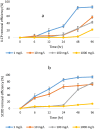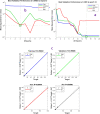4-chlorophenol removal by air lift packed bed bioreactor and its modeling by kinetics and numerical model (artificial neural network)
- PMID: 33436785
- PMCID: PMC7804011
- DOI: 10.1038/s41598-020-79968-7
4-chlorophenol removal by air lift packed bed bioreactor and its modeling by kinetics and numerical model (artificial neural network)
Abstract
4-chlorophenol (4-CP) is a hazardous contaminant that is hardly removed by some technologies. This study investigated the biodegradation, and physical 4-CP removal by a mixed microbial consortium in the Airlift packed bed bioreactor (ALPBB) and modeling by an artificial neural network (ANN) for first the time. The removal efficiency of ALPBB was investigated at 4-CP(1-1000 mg/L) and hydraulic retention time (HRT)(6-96 hr) by HPLC. The results showed that removal efficiency decreased from 85 at 1 to 0.03% at 1000 mg/L, with increasing 4-CP concentration and HRT decreasing. BOD5/COD increased with increasing exposure time and concentration decreasing, from 0.05 at 1000 to 0.96 at 1 mg/L. With time increasing, the correlation between COD and 4-CP removal increased (R2 = 0.5, HRT = 96 h). There was a positive correlation between the removal of 4-CP and SCOD by curve fitting was R2 = 0.93 and 0.96, respectively. Moreover, the kinetics of 4-CP removal follows the first-order and pseudo-first-order equation at 1 mg/L and other concentrations, respectively. 4-CP removal modeling has shown that the 2:3:1 and 2:4:1 were the best structures (MSE: physical = 0.126 and biological = 0.9)(R2allphysical = 0.999 and R2testphysical = 0.999) and (R2allbiological = 0.71, and R2testbiological = 0.997) for 4-CP removal. Also, the output obtained by the ANN prediction of 4-CP was correlated to the actual data (R2physical = 0.9997 and R2biological = 0.59). Based on the results, ALPBB with up-flow submerged aeration is a suitable option for the lower concentration of 4-CP, but it had less efficiency at high concentrations. So, physical removal of 4-CP was predominant in biological treatment. Therefore, the modification of this reactor for 4-CP removal is suggested at high concentrations.
Conflict of interest statement
The authors declare no competing interests.
Figures






Similar articles
-
Biodegradation of 4-chlorophenol in an airlift inner loop bioreactor with mixed consortium: effect of HRT, loading rate and biogenic substrate.3 Biotech. 2016 Dec;6(2):117. doi: 10.1007/s13205-016-0435-5. Epub 2016 Jun 2. 3 Biotech. 2016. PMID: 28330191 Free PMC article.
-
COD, para-chlorophenol and toxicity removal from para-chlorophenol containing synthetic wastewater in an activated sludge unit.J Hazard Mater. 2006 May 20;132(2-3):226-31. doi: 10.1016/j.jhazmat.2005.09.040. Epub 2005 Oct 27. J Hazard Mater. 2006. PMID: 16257114
-
Para-chlorophenol containing synthetic wastewater treatment in an activated sludge unit: effects of hydraulic residence time.J Environ Manage. 2007 Jul;84(1):20-6. doi: 10.1016/j.jenvman.2006.04.002. Epub 2006 Jul 11. J Environ Manage. 2007. PMID: 16814923
-
Anaerobic biodegradation of high strength 2-chlorophenol-containing synthetic wastewater in a fixed bed reactor.Chemosphere. 2008 Oct;73(5):705-10. doi: 10.1016/j.chemosphere.2008.06.072. Chemosphere. 2008. PMID: 18706674
-
Upflow anaerobic sludge blanket reactor--a review.Indian J Environ Health. 2001 Apr;43(2):1-82. Indian J Environ Health. 2001. PMID: 12397675 Review.
Cited by
-
Predictive modeling for the adsorptive and photocatalytic removal of phenolic contaminants from water using artificial neural networks.Heliyon. 2024 Sep 20;10(19):e37951. doi: 10.1016/j.heliyon.2024.e37951. eCollection 2024 Oct 15. Heliyon. 2024. PMID: 39386831 Free PMC article. Review.
-
The toxicity of SiO2 NPs on cell proliferation and cellular uptake of human lung fibroblastic cell line during the variation of calcination temperature and its modeling by artificial neural network.J Environ Health Sci Eng. 2021 Apr 30;19(1):985-995. doi: 10.1007/s40201-021-00663-4. eCollection 2021 Jun. J Environ Health Sci Eng. 2021. PMID: 34150286 Free PMC article.
-
Modelling of n-Hexadecane bioremediation from soil by slurry bioreactors using artificial neural network method.Sci Rep. 2022 Nov 16;12(1):19662. doi: 10.1038/s41598-022-21996-6. Sci Rep. 2022. PMID: 36385121 Free PMC article.
References
-
- Daraei H, Kamali H. Synthesis of iron nanoparticles and evaluation of their operation in phenol and 2-chlorophenol removal from aqueous solution. J. Health Field. 2014;1(3):31–40.
-
- Aldrich, S. Product comparison guide (4-Chlorophenol): Sigma Aldrich. (2017) http://www.sigmaaldrich.com/catalog/substance/4chlorophenol1285610648911....
Publication types
LinkOut - more resources
Full Text Sources
Other Literature Sources
Miscellaneous

